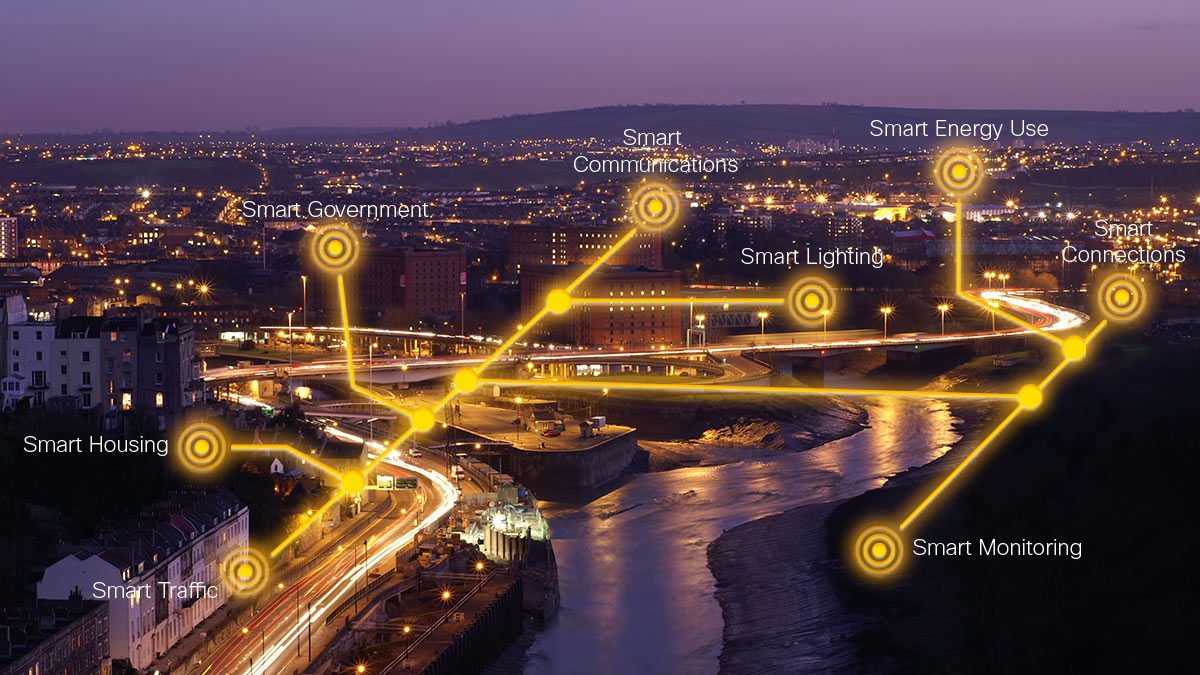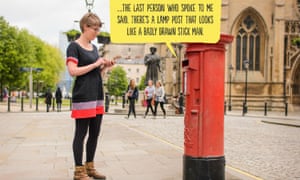Bristol Smart City – Hello Lampost
Summary
Hello Lamp post Spyware. A new project that allows city dwellers to converse with urban objects begins in Bristol this July. We speak to the creators about this fascinating collision of Smart Cities and location-based gaming. You may well have […]

You may well have heard of the Internet of Things, a concept first named by Kevin Ashton of MIT in 1999, in which separate objects fitted with the relevant sensors can be formed into useful information networks. A common example is the idea of an intelligent home, where switching on your bedside lamp in the morning will inform the coffee maker downstairs to start percolating. On a wider scale, we also talk about Smart Cities, in which infrastructures speak to each other, allowing, say, the organic management of vehicular traffic flow. All very interesting and all quite serious and functional.
Last year, the MIT Technology Review designated 2013 the year of the Internet of Things, and in response the Watershed arts venue in Bristol announced its Playable City Award. Working in conjunction with the council as well as local universities and tech businesses, the venue invited ideas on how the urban environment could be explored by residents and visitors in a more game-like way.
The winning entry was Hello Lamp Post by PAN Studio. This fascinating project encourages visitors and residents to communicate with street furniture like lamp posts, post boxes and bus stops by using the repair numbers found on these objects as SMS codes. Participants simply text the relevant number to a central server thereby ‘waking up’ the object, which will then ask a series of questions via text messaging. The next person to ‘sign in’ with that object can learn about previous replies, and the idea is, regular ‘conversations’ with the same objects will allow players to learn lots of stories about the hidden lives of the city’s population.
“We are a generation of designers for whom the internet of things is impossible to ignore,” says PAN co-founder, Ben Barker. “We understand that objects are often the visible element in far more complex systems, whether that’s Bergs Little Printer or a bin that know when it’s full. We came to Hello Lamp Post knowing that all the ‘things’ were already in place, our challenge was to build a network, one that united all these smart systems for a more human outcome.”
The team spent the early months of the project thinking about memory and city, and how we build our own psychogeographies of familiar environments. “Personally I was inspired by Austerlitz, a novel by Seabald in which the city was a walkable version of the protagonists brain,” says Barker. “We became obsessed with how we put these memories back in the real world, how do we unite the physicality of the city and the stories we tell about it?
“In all our conversations we were keen to avoid making an application that would limit who could play. Using SMS and the codes on objects we could avoid GPS and make it accessible to all. By making it open to everyone, all players needed was an interest in the stories of others.”
The technology behind Hello Lamp Post is relatively straightforward. A web server runs the backend, talking Twilio, a cloud communications platform. “Twilio is great,” says co-developer, Tom Armitage. “It handles turning text into SMS, and sending incoming SMSes to our web server. Most of our development effort is going into parsing what the player says. Without spoiling too much of the magic, the trick here is not trying to be too clever. Natural language processing is a huge and complex domain, and still very difficult to do right. So rather than being too sophisticated, we’re instead focusing on making sure the objects are always saying something that makes sense, and using content and tone to shape the conversations.”
In essence, it’s sort of a cross between a chat forum and an Artificial Intelligence conversation system – but one that can be accessed through sending text messages to a manhole cover. The idea evolved over several months of planning. “Our process is one of continual prototyping and slow evolution,” says Armitage. “We’ve always had the basic idea of what a conversation should feel like – but it’s turned out to be the details of the implementation that are most important. So we’ll explore what a conversation might feel like, first with pen and paper – drawing up flowcharts, sample dialogue – and once we have some logic laid out, we’ll code it up and see what it feels like when it’s in your hand, on a small screen – and we see what all the edge cases we hadn’t thought about lead to! And then we’ll iterate on that.”
For Armitage, Hello Lamp Post is a way of claiming back the term ‘Smart Cities’ from the big corporations and infrastructure organisations who tend to use it while marketing their own platforms – IBM’s Smarter Planet initiative being a prime example. But cities have always been shaped by their inhabitants as much as by government, commerce and real estate, and local areas become invested with local stories that exist beyond official histories. Hello Lamp Post is exploring that side of things – and it is part of wave of activity in this area.
“It’s exciting to see lots of great thought going on around alternate versions of the Smart City,” says Armitage. “And it’s thought that really focuses on all the other elements that make up a city – not just its technology. Dan Hill, CEO of Fabrica (and formerly Arup and Sitra) has a great recent blogpost on this. The work of New York-based designer Adam Greenfield also explores designing not only for networked cities, but also network citizens.
“There’s a long tradition of technology reshaping the city by harnessing its citizens – services like Foursquare or Dodgeball, games like MogiMogi, even cycle hire platforms like Vélib. These all alter and improve the city through technology and people. We’re taking some of that DNA and then investing the city with some personality.”

The idea of harnessing cities as playful spaces is an attractive one, especially when it’s about concentrating attention, not on the big buildings and official tourist attractions, but on the little objects that get overlooked. Games have been using city environments for many years, and we’re seeing a huge rise in experiences like 2.8 Hours Later, a team-based zombie chase game that has visited several cities in the UK. Meanwhile, the dawn of location-based and augmented reality gaming will offer up entirely new collisions between meatspace, game space and player.
For now, Hello Lamp Post is a simple and inclusive introduction to the idea of the Internet of Things, which won’t require a cutting edge Smartphone or Google Glasses. It is also preparing us for a future in which the stuff that surrounds us, from TVs to toasters to tube trains, will be networked and communicative. The game says that a part of this weird future will be investing something of ourselves, something human, in inanimate objects.
“Personality is a subtle but often under-used design element,” says Armitage. “Berg’s Little Printer doesn’t just have a face because it looks cute; it’s because the whole product has a kind of personality. It’s not pretending to be human, but it’s more than just a device. When you unpack it, you name it; the whole language of the product becomes a dialogue between it and the user. And it really changes how you engage with the device.
“We’re hoping that by encouraging people to engage in conversation with objects, to put themselves in their shoes, rather than just complete tasks or score points, we might be able to more effectively alter their perspective of their city – to change how they see it.”
Hello Lamp Post runs throughout Bristol from 19 July to 8 September. You can find out more at the Watershed site, here.